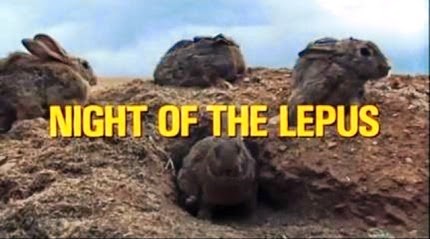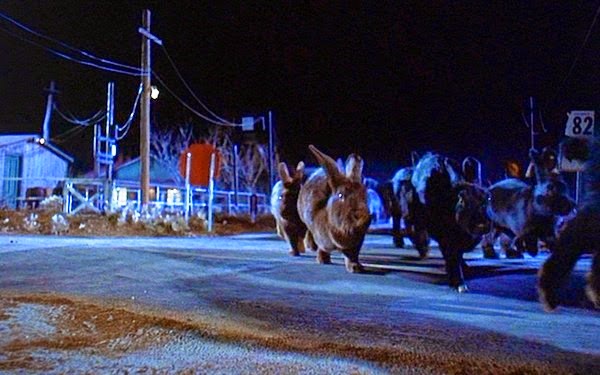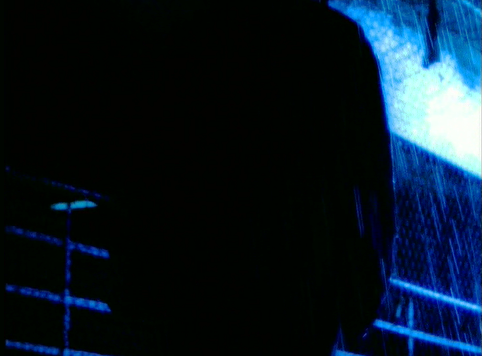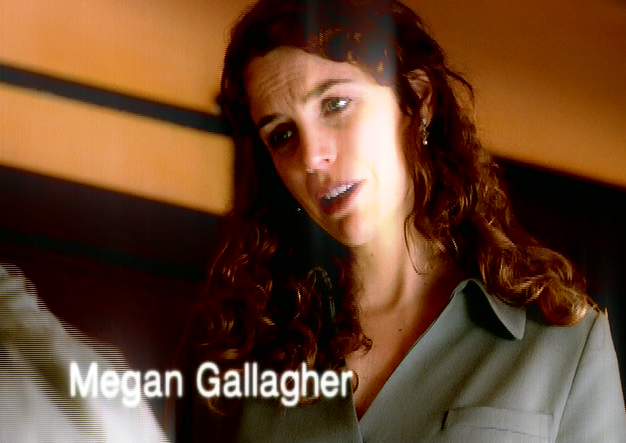 |
| Cause and effect: In the foreground, the face of death. In the background, animal instinct takes over. |
Creator of the audio drama Enter The House Between. One of the horror genre's "most widely read critics" (Rue Morgue # 68), "an accomplished film journalist" (Comic Buyer's Guide #1535), and the award-winning author of Horror Films of the 1980s (2007), The Rock and Roll Film Encyclopedia (2007) and Horror Films of the 1970s (2002), John Kenneth Muir, presents his blog on film, television and nostalgia, named one of the Top 100 Film Studies Blog on the Net.
Saturday, July 30, 2022
50 Years Ago Today: Deliverance (1972)
 award-winning creator of Enter The House Between and author of 32 books including Horror Films FAQ (2013), Horror Films of the 1990s (2011), Horror Films of the 1980s (2007), TV Year (2007), The Rock and Roll Film Encyclopedia (2007), Mercy in Her Eyes: The Films of Mira Nair (2006),, Best in Show: The Films of Christopher Guest and Company (2004), The Unseen Force: The Films of Sam Raimi (2004), An Askew View: The Films of Kevin Smith (2002), The Encyclopedia of Superheroes on Film & Television (2004), Exploring Space:1999 (1997), An Analytical Guide to TV's Battlestar Galactica (1998), Terror Television (2001), Space:1999 - The Forsaken (2003) and Horror Films of the 1970s (2002).
award-winning creator of Enter The House Between and author of 32 books including Horror Films FAQ (2013), Horror Films of the 1990s (2011), Horror Films of the 1980s (2007), TV Year (2007), The Rock and Roll Film Encyclopedia (2007), Mercy in Her Eyes: The Films of Mira Nair (2006),, Best in Show: The Films of Christopher Guest and Company (2004), The Unseen Force: The Films of Sam Raimi (2004), An Askew View: The Films of Kevin Smith (2002), The Encyclopedia of Superheroes on Film & Television (2004), Exploring Space:1999 (1997), An Analytical Guide to TV's Battlestar Galactica (1998), Terror Television (2001), Space:1999 - The Forsaken (2003) and Horror Films of the 1970s (2002).
Thursday, July 28, 2022
Tales of Sley House: Interview with author Matthew Allair
I recently had the opportunity to catch up with Matt Allair, an author I have known and worked with many times over the years. He recently participated in a new horror anthology, Tales of Sley House, and I wanted to learn more about the genre collection, and his contribution, "Ghostly Visions," which evoked for me a sense of classic horror, reminiscent of both Lovecraft and 1970's TV efforts like Night Gallery.
John Kenneth Muir: Share with the readers how you came to be involved with Tales of Sley House, and what the anthology is all about. What can you tell us about the publisher, and the project?
Matthew Anthony Allair: I am online friends with Richard Billingsley, a very fine author, due to our shared interest in the Paranormal. When his son Jeremy, another fine author, announced the launch of Sley House Publishing, and would soon be accepting submissions for short story authors, I leapt at the chance to be a part of the first anthology collection. I guess the flavor of the anthology is a little like the Crypt Keeper from the old 50s EC comics Tales from The Crypt. Sley House is a place to give new authors a chance to showcase their work. I like the attitude of the editors at Sley House, very pro author friendly. The editors, K.A. Hough and Trevor Williamson are quite good. I can’t go into specifics, but there were over sixty submissions and fifteen authors selected, so it’s a real honor to be a part of it.
JKM: Tell me about your story, "Ghostly Visions."
MAA: “Ghostly Visions” is about an art historian named Rogelio who is recruited by an art curator to visit a small town near Madrid, Spain to review a recently unearthed Francisco Goya painting titled ‘Ghostly Vision’ that connected to Goya’s black paintings period, but there’s a strange a dark history that connects all of it and things take a supernatural turn. A lot of my prose work is very cinematic.
JKM: What made you want to tell this story, in particular? What themes did you want to explore in a horror setting?
MAA: Well, a friend shared news about this recently rediscovered painting titled ‘Ghostly Vision’ which was credited to Francisco Goya, so it appears to be a very real work, I had already been writing prose since Jan 2021, when I saw the painting, the first idea that came to mind was Rod Serling’s Night Gallery, I then thought – someone should build a story around the painting, - then I realized I might as well do it. I had some strong ideas, but it wasn’t until I had completed the research into Francisco Goya, his work with the Black Painting period, and some of the stranger work like the Colossus, some of the stranger things about Goya’s personal life, then all of the dots connected, and the story almost wrote itself, uncanny really. For example, there’s a small sequence where the characters pass through a town where they find an open coffin with a headless corpse, that is taken from Goya’s passing, and the strangeness over his burial. The themes have to do with the power of symbols, mythology, and self belief in the power of fate. There’s a fixation towards Apocalyptic imagery, or a romanticism towards Dystopia’s. ‘Ghostly Visions’ and several others tales in my work are a reaction or comment to such interests. Most people are prone to self destruction I have found, and it takes a lot of work to not lose your way. Be careful what you wish for.
JKM: I know you, from years back, because we are both obsessed with The X-Files, and have both written about it in length. The idea in "Ghostly Visions" of belief vs. nonbelief, and figurative demons vs. psychological demons, feels apiece with the series' terrain. Would you say that is the case? Could the story of Rogelio be an X-File?
MAA: Well, The X-Files will always be close to my heart, the story isn’t directly influenced by The X-Files, I have very broad interests and influences aside from The X-Files, the themes of belief vs. non belief, and figurative vs. psychological demons have always fascinated me, there’s a lot of truth to the idea of Carl Jung’s notions about the shadow self, and how we need to overcome it. I suppose post event, that Mulder and Scully would be interested in the case. Yet being that it is set within international waters - unless the painting made the rounds in the United States - and an investigation called for their travel to Spain, I suspect the case would be out of their jurisdiction. I have always found a connection between Rod Serling, Leslie Stevens, Gene Roddenberry, and Chris Carter. I think all four are visionaries.
JKM: You set "Ghostly Visions" in the world of art collection, and European history. Are those subjects that are of special interest for you, and how does it the idea of a lost historic masterpiece fit with your vision? (And were you inspired at all by Lovecraft?)
MAA: I have an art college background, as much as film and story telling have always been my passion, so using the setting of the art world felt very much at home. As much as I have real problems with the industry politics of the art world, it’s a subject I am familiar with - the pros and cons. As far as lost masterpieces are concerned, there’s a lot of hidden history that people keep rediscovering, it doesn’t help that the world is in such turmoil at the moment. We have entered the 21st century and there’s a lot of adjustments we are facing, and we don’t know which direction we are going to go towards. It seems we have to deal with the past before we can move forward as a society.
As far as the Lovecraft influence, I saw Alien in 1979 and it scared the Hell out of me as a kid, but the film, and H.R. Giger, left an inkling, an imprint of ideas to explore. The Lovecraftian themes were embedded in me before I even knew who he was. A few years later in the early 80s when I got into Dungeons and Dragons, the Lovecraft mythos was used in campaigns, this would have been around sixth grade. Flash forwards a few years later when I was a freshman in High School, I got seriously into reading H.P. Lovecraft, and I mean, I read everything… including his poems and ‘Supernatural Horror In Literature’. But over time, the author and filmmaker who influenced me more was Clive Barker, there is a fearlessness in his work, his willingness to explore taboos, that influenced me to explore certain ideas, as much as I could never be as extreme as Clive is capable of being in his work, Clive really evolved my thinking about the terror and horror genres.
JKM: Where can readers find Tales of Sley House, and what are you working on now? Where can we find other examples of your work?
MAA: The anthology collection Tales of Sley House has some very fine stories and authors, aside from my tale, so I hope people will check it out. You can order it through Amazon, Barnes and Nobles or directly through the publisher at Sley House. You can also special order it through Copperfields.
I started writing prose work in Jan 2021, and I hope the beginning association with Sley House will lead to something further, you never know. I have been pretty honest on Facebook about my journey with the work. I have two apocalyptic horror novellas, The Sea House and Trail of Tears that are pretty dark. I have a fantasy tale that is close to a novel, Sky Riders, could be described as Edgar Rice Burroughs meets George R.R. Martin. A hard science / science fiction tale, Redline, and various short terror and horror tales, The Silk Naif and The Gnat, Mesh, The Rooster That Would Not Stop, and The Last Shot. All of these are in various stages of editing, rewrites ,and proofing. My goal is to get a short story collection of these tales published, it depends on the marketplace.
If I do get these published, I have nine other short story ideas, and two novel ideas, so a few more books in me, it all depends of future sales. I am also working with artists on three of these tales to do a graphic novel edition. One UK artist is in fact doing an illustrated version of Ghostly Visions, but again, it depends on if a comic publisher will be interested. I have been screen writing as well, and a friend is helping me to shoot a short horror film titled Roads before the summers end. I hope to get back on track with my three half hour films for Lotus Light Productions, a horror tale; a period gold rush tale; and a pre-World War II British espionage thriller that I am excited about. Basically, I am working in three mediums, prose work, graphic novels and films, so it’s stimulating for me. I hope all will see the light of day. That is what I am working on.
I want to thank Matt for sharing this information on the blog, and those looking to learn more about Tales of Sley House can visit the publisher, here.
 award-winning creator of Enter The House Between and author of 32 books including Horror Films FAQ (2013), Horror Films of the 1990s (2011), Horror Films of the 1980s (2007), TV Year (2007), The Rock and Roll Film Encyclopedia (2007), Mercy in Her Eyes: The Films of Mira Nair (2006),, Best in Show: The Films of Christopher Guest and Company (2004), The Unseen Force: The Films of Sam Raimi (2004), An Askew View: The Films of Kevin Smith (2002), The Encyclopedia of Superheroes on Film & Television (2004), Exploring Space:1999 (1997), An Analytical Guide to TV's Battlestar Galactica (1998), Terror Television (2001), Space:1999 - The Forsaken (2003) and Horror Films of the 1970s (2002).
award-winning creator of Enter The House Between and author of 32 books including Horror Films FAQ (2013), Horror Films of the 1990s (2011), Horror Films of the 1980s (2007), TV Year (2007), The Rock and Roll Film Encyclopedia (2007), Mercy in Her Eyes: The Films of Mira Nair (2006),, Best in Show: The Films of Christopher Guest and Company (2004), The Unseen Force: The Films of Sam Raimi (2004), An Askew View: The Films of Kevin Smith (2002), The Encyclopedia of Superheroes on Film & Television (2004), Exploring Space:1999 (1997), An Analytical Guide to TV's Battlestar Galactica (1998), Terror Television (2001), Space:1999 - The Forsaken (2003) and Horror Films of the 1970s (2002).
Tuesday, July 26, 2022
50 Years Ago Today: Night of the Lepus (1972)
But by the mid-point of the decade, filmmakers were almost constantly coupling vicious animal behavior with man’s massive and on-going mistreatment of the environment.
Pesticide-spraying man battles spiders in Kingdom of the Spiders (1977).
Toxic-waste dumping man faces insect rebellion in Empire of the Ants (1977).
Other films of the same ilk including The Bug (1975), Squirm (1976), Day of the Animals (1977), and perhaps the most infamous revenge of nature movie of all: Night of the Lepus.
Before long, the ranchers and law enforcement officials near Ajo are waging a war against giant carnivorous bunnies with teeth the size of “saber tooth tigers.”
The big problem with the film is that as avatars of fear, rabbits are rather un-intimidating creatures. Even with red paint splattered on their whiskery mouths.
In fact, these giant rabbits hop around -- or rather “stampede” -- across miniature sets in slow-motion, in full view of the camera for long, dull stretches of the running time, and the result is underwhelming to say the least.
But a herd of giant carnivorous rabbits escape from this trap, and make a run for Ajo, where they have the capacity to do major damage in terms of life and property value.
The movie plays on-screen during the scene in which Neo (Keanu Reeves) visits the Oracle, and sees children bending spoons. The subtle suggestion is that a movie like Night of the Lepus -- about a “herd of killer rabbit” -- could only exist in a weird facsimile of reality.
Again, this is a fear that should not be named, specifically. Even the very word, "rabbit," doesn't promote scares.
But on the other hand, Claxton goes way over-the-top in terms of fake-looking gore, a step which moves the film out of the zone of realism. The scene vacillates between deadly dull conversations and over-the-top moments of ridiculous violence, and the approach is not pleasing.
Roger Greenspun, writing in The New York Times, noted the “technical laziness,” “stupid story” and “dumb direction,” a kind of trifecta of utter terrible-ness.
Alan Frank, in 1982, treated the film more gently, though drew the same conclusion, noting that the “enlarged rabbits” don’t “really carry a genuine monstrous charge.”
And yet beyond that, this is a horror film unable to enunciate even a single moment of authentic horror.
 award-winning creator of Enter The House Between and author of 32 books including Horror Films FAQ (2013), Horror Films of the 1990s (2011), Horror Films of the 1980s (2007), TV Year (2007), The Rock and Roll Film Encyclopedia (2007), Mercy in Her Eyes: The Films of Mira Nair (2006),, Best in Show: The Films of Christopher Guest and Company (2004), The Unseen Force: The Films of Sam Raimi (2004), An Askew View: The Films of Kevin Smith (2002), The Encyclopedia of Superheroes on Film & Television (2004), Exploring Space:1999 (1997), An Analytical Guide to TV's Battlestar Galactica (1998), Terror Television (2001), Space:1999 - The Forsaken (2003) and Horror Films of the 1970s (2002).
award-winning creator of Enter The House Between and author of 32 books including Horror Films FAQ (2013), Horror Films of the 1990s (2011), Horror Films of the 1980s (2007), TV Year (2007), The Rock and Roll Film Encyclopedia (2007), Mercy in Her Eyes: The Films of Mira Nair (2006),, Best in Show: The Films of Christopher Guest and Company (2004), The Unseen Force: The Films of Sam Raimi (2004), An Askew View: The Films of Kevin Smith (2002), The Encyclopedia of Superheroes on Film & Television (2004), Exploring Space:1999 (1997), An Analytical Guide to TV's Battlestar Galactica (1998), Terror Television (2001), Space:1999 - The Forsaken (2003) and Horror Films of the 1970s (2002).
Saturday, July 23, 2022
Five Favorite Frank Black Moments from Chris Carter's Millennium (1996-1999)
There can be little doubt that Lance Henriksen's Frank Black is our sturdy anchor in the great Chris Carter series, Millennium (1996 - 1999).
Over a span of three seasons and more than sixty episodes, this remarkable dramatic program accommodated many different brands and styles of storytelling -- including some unexpected lunges into comedy -- and the face who always held it all together belongs to Lance Henriksen.
As the series opens, Frank Black and his family relocate to rainy Seattle, but -- caring spouse and supporting father that he is -- Frank has made certain that their lives have at least a ray of sunshine in them.
Far away from the yellow house in Seattle, Frank Black deciphers a clue that suggests Evil Itself (in the form of Sarah Jane-Redmond's Lucy Butler), is on the way to "visit" his imperiled family. And this time, Frank is too far away to help them.
And sure enough, when Frank's friend Bletch enters the yellow house during a storm -- now a yellow house of horrors -- be afraid. Be very afraid...
3. "Jose Chung's Doomsday Defense:" Don't Be Dark, Frank.
In this caustic satire of Scientology (called Self-osophy in Millennium), Frank attempts to ferret out the identity of a killer by using a copyrighted Self-osophy self-help technique.
Horrified, Black rips off the head-set and nurses the mother of all headaches. But the point is that Frank doesn't run from the darkness or try to deny it. He faces it. He isn't about "self" (or Self-osophy) and sometimes we all genuinely need to "be dark."
An exhausted, freezing Frank Black carries an injured young man named Alex through the hostile, wooded terrain of wild Alaska in the uplifting "Luminary."
This courageous and self-less act represents Frank's ethos in a nutshell. It's that father instinct. It's that tenacious unwillingness to give up on someone he has sworn to protect. He will literally do anything to help another human being, even at great risk to himself.
Alone in the wild again, Frank is badly injured and experiences a vision that, in some small way, forces him to face his greatest loss.
 award-winning creator of Enter The House Between and author of 32 books including Horror Films FAQ (2013), Horror Films of the 1990s (2011), Horror Films of the 1980s (2007), TV Year (2007), The Rock and Roll Film Encyclopedia (2007), Mercy in Her Eyes: The Films of Mira Nair (2006),, Best in Show: The Films of Christopher Guest and Company (2004), The Unseen Force: The Films of Sam Raimi (2004), An Askew View: The Films of Kevin Smith (2002), The Encyclopedia of Superheroes on Film & Television (2004), Exploring Space:1999 (1997), An Analytical Guide to TV's Battlestar Galactica (1998), Terror Television (2001), Space:1999 - The Forsaken (2003) and Horror Films of the 1970s (2002).
award-winning creator of Enter The House Between and author of 32 books including Horror Films FAQ (2013), Horror Films of the 1990s (2011), Horror Films of the 1980s (2007), TV Year (2007), The Rock and Roll Film Encyclopedia (2007), Mercy in Her Eyes: The Films of Mira Nair (2006),, Best in Show: The Films of Christopher Guest and Company (2004), The Unseen Force: The Films of Sam Raimi (2004), An Askew View: The Films of Kevin Smith (2002), The Encyclopedia of Superheroes on Film & Television (2004), Exploring Space:1999 (1997), An Analytical Guide to TV's Battlestar Galactica (1998), Terror Television (2001), Space:1999 - The Forsaken (2003) and Horror Films of the 1970s (2002).
Chris Carter's Millennium (1996 - 1999): Opening Montage
As disaster looms, the road ahead is unknown. How do we avert the crisis? Stay in the same lane? Change lanes? What course do we take?
Can we run away from the Evil?
We seem to be stalking a shadowy woman in the next shot as the legend "worry" appears on screen. This word is yet another symbol of an overwhelming sensory fear, this anticipatory anxiety.
In this case, the woman -- whose face remains unseen -- walks towards the light, but the position of the shot reveals important information that she does not have access to.
We are watching her from the bushes. We are spying on her. The evil is ready to jump, to reveal itself...and she is unprepared.
Can that peace last?
Millennium -- and its gorgeous but discomforting introduction montage -- showcases the idea that the wolf is already at our door...and perhaps inside the house.
 award-winning creator of Enter The House Between and author of 32 books including Horror Films FAQ (2013), Horror Films of the 1990s (2011), Horror Films of the 1980s (2007), TV Year (2007), The Rock and Roll Film Encyclopedia (2007), Mercy in Her Eyes: The Films of Mira Nair (2006),, Best in Show: The Films of Christopher Guest and Company (2004), The Unseen Force: The Films of Sam Raimi (2004), An Askew View: The Films of Kevin Smith (2002), The Encyclopedia of Superheroes on Film & Television (2004), Exploring Space:1999 (1997), An Analytical Guide to TV's Battlestar Galactica (1998), Terror Television (2001), Space:1999 - The Forsaken (2003) and Horror Films of the 1970s (2002).
award-winning creator of Enter The House Between and author of 32 books including Horror Films FAQ (2013), Horror Films of the 1990s (2011), Horror Films of the 1980s (2007), TV Year (2007), The Rock and Roll Film Encyclopedia (2007), Mercy in Her Eyes: The Films of Mira Nair (2006),, Best in Show: The Films of Christopher Guest and Company (2004), The Unseen Force: The Films of Sam Raimi (2004), An Askew View: The Films of Kevin Smith (2002), The Encyclopedia of Superheroes on Film & Television (2004), Exploring Space:1999 (1997), An Analytical Guide to TV's Battlestar Galactica (1998), Terror Television (2001), Space:1999 - The Forsaken (2003) and Horror Films of the 1970s (2002).
Guest Post: Immaculate (2024)
' An Immaculate Ass Kicking By Jonas Schwartz-Owen John Wick for the rectory set, Immaculate i s a vicious satire of religious fa...
-
My friend, Johnny Byrne (27 November 1935 – 3 April 2008) -- an Irish poet, philosopher and writer on science fiction TV series such as Sp...
-
How did my love for the movies actually begin? Was it at the drive-in double features (where I saw Death Race 2000 [1975] and Lege...












































